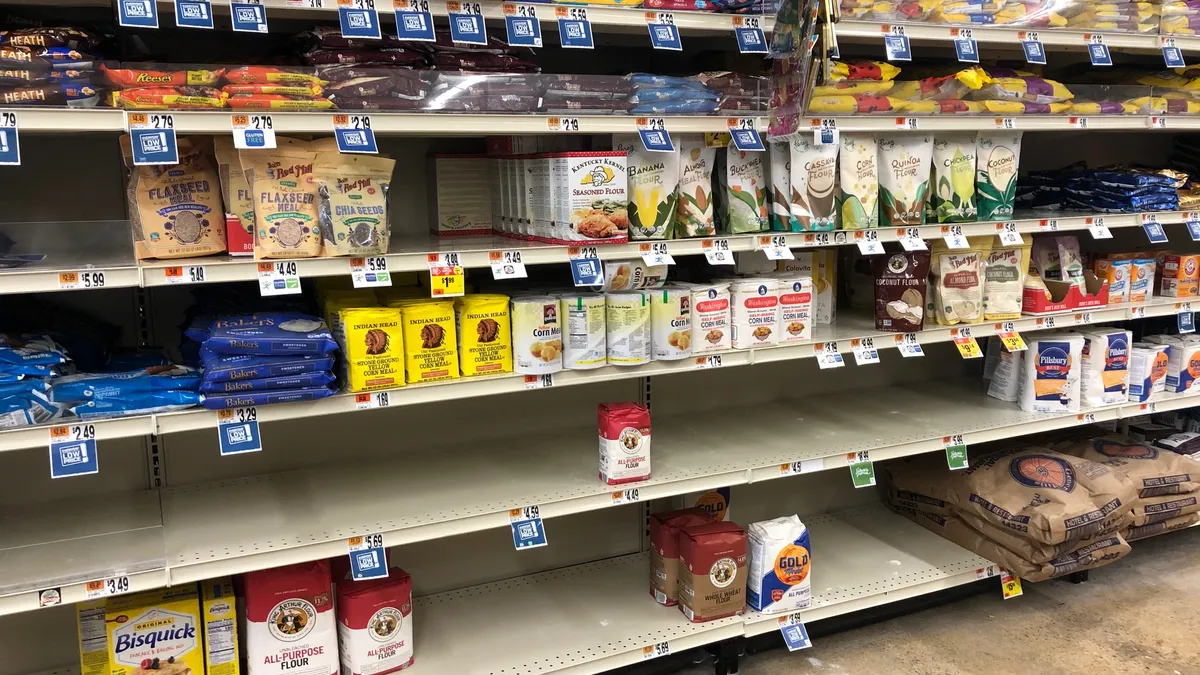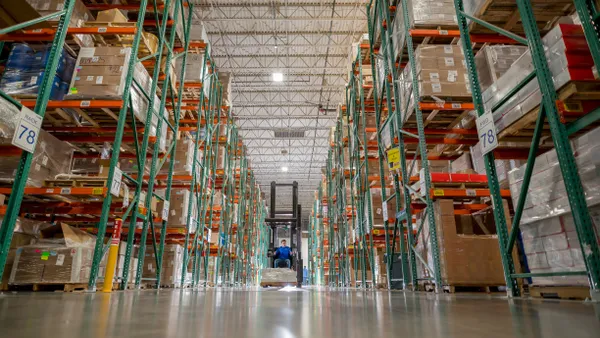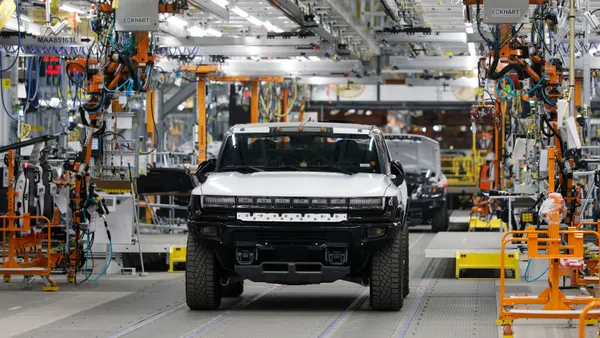Dive Brief:
- Fifty-one percent of shippers consider the lack of clarity on consumer demand to be the biggest supply chain bottleneck they are seeing as a result of the COVID-19 pandemic, according to a CalAmp and Reuters Events survey of 587 supply chain executives, including 202 shippers, from across the globe.
- "The pandemic has introduced unexpected volatility into customer demand, making it even more difficult to discern demand patterns," according to a white paper released along with the survey. "Furthermore, silos between sales and operations has hindered data-sharing which would have proven useful in navigating these issues."
- Some larger retailers have dealt with increased demand for groceries and household items by tuning routing and capacity management systems for smaller baskets and shorter delivery windows, the report said.

Dive Insight:
The coronavirus pandemic has upended forecasts, machine learning algorithms and other predictive analytics methods used by companies to understand and predict consumer demand, according to John Aloysius, a professor in the supply chain management department at the University of Arkansas who has been working with companies to understand the pandemic's impact on analytics.
"Over the last few years ... with the increasing availability of data, for example, a lot of these decisions were becoming increasingly automated," Aloysius said. The automated forecasts would be used to inform decisions made by human workers, he said.
Models used to predict consumer demand look at hundreds or even thousands of variables, including purchasing trends, sales promotions and seasonality. They tend to do well at identifying variability in the system during normal times.
But statistical models work best when making predictions in a consistent environment. The coronavirus pandemic was a sharp turn off the consistent course of demand for many products.
Black swan events, such as the pandemic, mean that "these models suddenly become much less useful because the variability in demand that you're going to see, it's no longer systematic," Aloysius said.
The issue arises as a result of the math used to create the models. Forecasts and machine learning models are trained on historical data. This informs the model and allows it to generalize what would most likely happen in a given situation based on what has happened in the past during similar events. And that's the problem: There are no past similar situations to help inform these models.
"It's not just say, an increasing trend; it's not just fairly predictable seasonal lifts," Aloysius said. "You know, everything's just like a completely different story and the historic data is no longer as relevant."
A model built to forecast the sales of cleaning products, for example, would have underestimated the demand seen during the pandemic, he said.
So, companies are turning to a much older supply chain planning tool: human judgment.
"And, this is where it just becomes so much harder, right?"Aloysius said. "Because even the humans — it's not like they really know what's going to happen, and that's the increasing uncertainty."
But a human's ability to pick up on cues and diagnose events significantly outpaces that of machine learning models, he said. Humans can read the news and and get a general grasp of the pandemic's effect on demand: more sales for cleaning supplies, less demand for clothing.
"The system's not able to figure that out," he said, referring to modeling methods.
Understanding the shape of these shifts, though, will require some human diagnostics. While demand might return to normal for some items, such as toilet paper, after a period of panic buying, others could see a permanent or more elongated shift in demand, he said.
"It's going to take several weeks, months, maybe even years in some cases before the automated systems catch up," Aloysius said.
There are some steps companies can take to help their models improve. Analysts will need to help the models understand that something has changed. One way would be introducing a variable to represent the pandemic, so the model can begin to learn that after a certain date everything is different than what came before. But then the company will need to collect enough post-pandemic data to begin training to model with this new variable included, he said.
What metrics do companies rely on while waiting on their models to play catch up? "That's the tough part," Aloysius said.
Companies will likely focus on what is happening locally, with store-level demand and local policy. Demand in New York, for example, might be different from the rest of the country. Companies should keep an eye on policy changes related to the pandemic at the local, state and federal level, he said.
This lack of clarity has been something companies have been fairly open about in recent earnings calls.
"Our ability to project how that’s going to play out over the balance of the quarter or year is unfortunately something that we can’t do today," Target CEO Brian Cornell said on an earnings call last month when an analyst asked about markdown plans. "I think there’s just too much uncertainty, too many different variables."
Walmart pulled its guidance for fiscal year 2021, citing "uncertainty around several key external variables and their potential impact on our business and the global economy."
"The uncertainty stems from some variables that could impact performance in either direction," Walmart CFO Brett Biggs said last month.
Nike also declined for provide guidance for fiscal 2021, citing uncertainty. But the company did say it would be leaning on data and analytics talent from its Celect acquisition to help to navigate the uncertainty.
Data will still be providing guideposts for companies, even if models struggle to make predictions on the available information.
"There's just a lot more human touch involved," Aloysius said.
This story was first published in our weekly newsletter, Supply Chain Dive: Operations. Sign up here.














